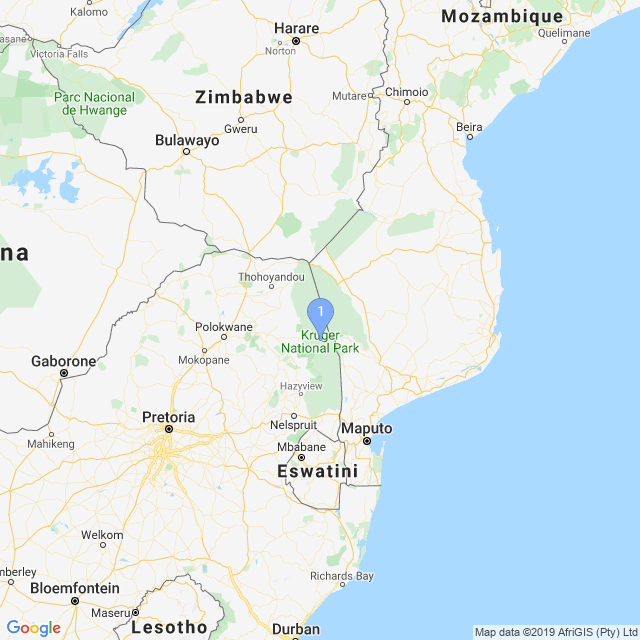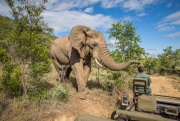The Wild Cats of Kruger: Kruger National Park lions, leopards, cheetahs, and other African cats
Kruger National Park is home to diverse wild cats, from small genets to great big lions, and many in between. If you’re lucky, you may spot a good few wild cats on your Kruger safari, along with a variety of other animals, including the herbivores of the Big 5.
It is hard to describe the feeling of being lucky enough to watch lions hunting, a cheetah hurtling across the savannah after a fleeing springbok or a leopard lazing on a branch in a giant jackal berry tree. Velvet coats, paired with fierce teeth and intense big cat gazes make for spectacular game viewing!
In this post, you'll see what African big cats and smaller wild cats inhabit Kruger National Park and find out more about these captivating felines.
Kruger National Park Lions (Panthera Leo)
 Lion cubs in Kruger National Park
Lion cubs in Kruger National Park
Lions live together in prides. The leader of the pride changes, but the pride itself remains cohesive, and under the control of the females. These female lions, often related, share jobs in the pride, from hunting to raising their cubs. Each Kruger lion pride has a specific territory and vicious fights break out if another pride tries to encroach.
Mostly active at night, they can usually be found where the big herds of game – their prey – hang out. Hunting at night, lions usually rest in the shade during the day but are sometimes spotted at dawn and dusk.
Lion Hunting
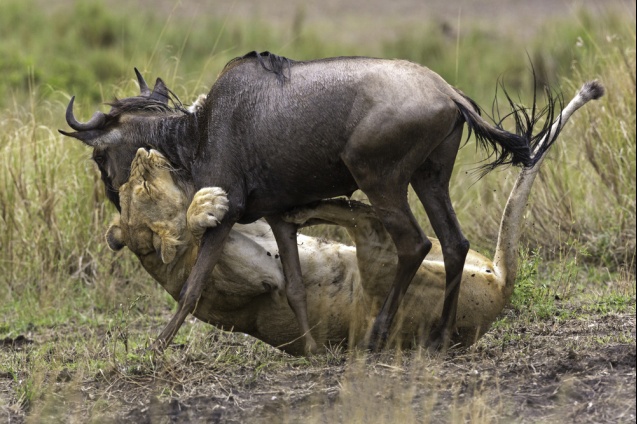 Lion hunt in Kruger National Park
Lion hunt in Kruger National Park
Unlike the speedy cheetah, lions can’t run that fast. This is unsurprising considering that males can weigh over 200 kg, the females slightly less. Thus, their hunting habits rely more on clever planning than speed. While they do sometimes hunt alone, their ‘two-pronged’ attack is often more successful. Here, one lion – usually a male – approaches the prey from upwind, driving it toward an ambush – usually females – behind it.
If the first attack doesn’t work, lions will seldom chase their prey very far, but they will – and do – have protracted fights to the death, especially with buffalo, if their prey is grounded but not dead with the first bite.
The African bush is not for sissies.
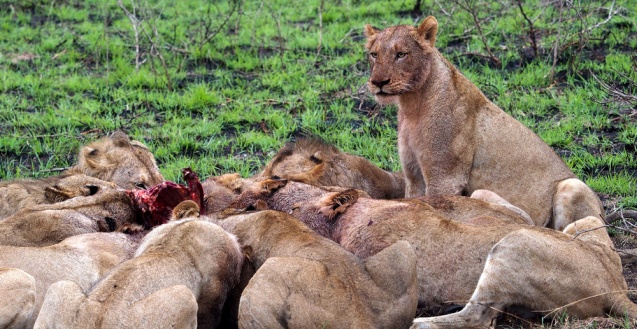 Lion pride in Kruger National Park
Lion pride in Kruger National Park
Once dead, the male eats first, the females second, and the cubs get whatever’s left. After that, the scavengers – who’ve been waiting patiently in the wings for up to 24 hours – come in and clean up, most commonly vultures, hyenas and jackals.
White Lions
 Kruger National Park White Lions
Kruger National Park White Lions
Contrary to popular belief, these incredibly rare lions are not albino, but rather a genetic rarity. Initially only found in the Timbavati area (part of Greater Kruger National Park), a cub was seen in 2014, a new member of the Satara pride, heralding much happiness.
Recent studies done on these blue-eyed beauties have shown that contrary to initial scientific thought, white lions hunt just as successfully as their tawny brothers and sisters.
Kruger National Park Lion All-Boys in the News
Yip, you read correctly. The ‘all-boys club’ made up of six young male lions in the Gomondwane region made it into the UK’s Daily Mail when one of their reporters spotted this crew on safari in Kruger National Park.
Thought to be made up of related males – brothers and cousins – groups like this travel through territories looking for suitable females to ‘settle down’ with, fighting any males who happen to get in their way.
Where to Find Lions in Kruger National Park
Lions are most commonly sighted in central and southern Kruger National Park, especially in the regions of Crocodile Bridge, Lower Sabie, Skukuza, and Satara.
For more about African lions see Lions in Africa: tips for your African lion safari and facts about these African big cats or Lion Safari in Africa: Where are lions in Africa?
Kruger National Park Leopards (Panthera pardus)
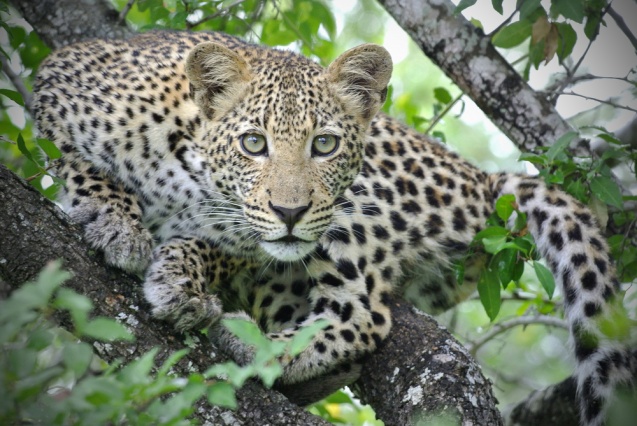 Leopard looking, Kruger Safari
Leopard looking, Kruger Safari
The next-biggest cat in Kruger National Park, with the male weighing in at over 60 kg, is the leopard. These exquisite felines are the shyest of the African big cats, preferring their own company and hanging out in the dense bush during the daylight hours, emerging only in the late afternoon to hunt for dinner.
This they usually do by stalking, pouncing, and killing with a swift bite to the neck. They then usually carry their prey – often heavier than themselves – into a tree, allowing them to snack over a couple of days away from the snarling grins of the scavengers.
An odd habit of leopards is that they often lick the fur off their prey, before eating.
In this video, a lion stalks and jumps on a leopard in Kruger National Park. A rare sighting to see these two creatures together!
Where to Find Leopards in Kruger National Park
Leopards are found, if you’re lucky, throughout Kruger National Park, preferring dense riverine forest – especially along the Sabie River – and rocky outcrops.
More about seeing leopards in African Leopard: How to spot leopards on safari
Kruger National Park Cheetah (Acinonyx jubatus)
 Cheetah in Kruger National Park
Cheetah in Kruger National Park
Lean and wily, the cheetah is built for speed and can run at speeds over 110 km/h. Weighing around 50 kg, cheetahs use their speed for hunting, catching their prey off-guard, and then running at it, at full speed. The prey – usually antelope – try to lose the cheetah by zig-zagging but, often, lose the battle as the cheetah uses his tail to stabilize himself.
The killing bit is not quite as effective as that of the lion and leopard, due to the cheetah’s small jaws and it takes up to half an hour for their prey to die. The only trouble a cheetah has is that its stamina is pretty low. It can only run full speed for about 250 m and needs to have a rest after the energy-sapping hunt. Unfortunately, during this rest, the cheetah often loses its prey to lions or scavengers - a very unfair outcome after all that effort.
Where to Find Cheetahs in Kruger National Park
Central Kruger National Park is the favourite spot for cheetah sightings and is around Lower Sabie and the Crocodile River.
The Difference between Leopard and Cheetah?
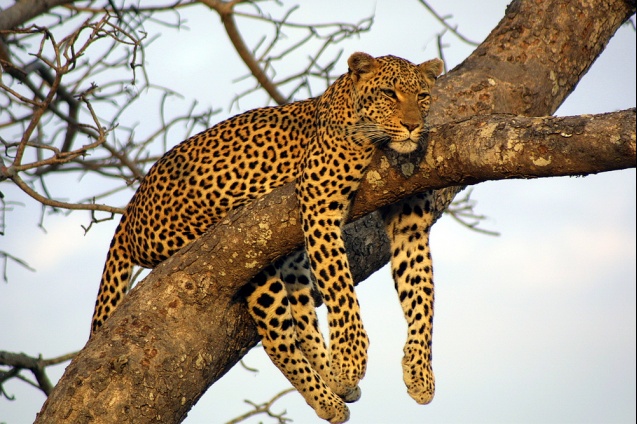 Leopard in Kruger National Park
Leopard in Kruger National Park
It is not uncommon for new safari-goers to confuse leopard and cheetah, due to the similarity of the spotted golden pelts of these African big cats. These felines do, however, differ significantly.
Leopards are far more powerfully built, with muscular limbs and a bigger, more cat-like head. Cheetahs are slender and gangly, with long bodies and smaller, almost dog-like heads. The leopard’s spots are big and rosette-like, while the cheetah has small spots and a very distinct black line on either side of the nose (tear lines).
If you get close to them – something we don’t recommend! – you will find that leopards have retractable claws, like a house cat, and cheetahs don’t, more like a dog.
Most visible though, is their habitats, leopards are shy and like dense bushes and cheetahs, not-so-much, hanging out on open savannah.
Take a closer look at Cheetah vs Leopard: What's the difference? to make sure you can tell the difference between them.
Caracal (Felis caracal)
 Caracal in Kruger National Park
Caracal in Kruger National Park
With their distinctive tufted ears and gorgeous red-brown coats, caracals are solitary night-time hunters. These exquisite animals are seldom spotted as they are secretive and solitary. Also, in contradiction to their beauty, they can be very aggressive.
Civet (Viverra civetta)
 Civet cat in Kruger National Park
Civet cat in Kruger National Park
These wild cats remind one of a badger, due to their distinctive grey faces with black and white markings. And their markings are what make them stand out: bands of black, grey, and white, with black legs.
They, too, are shy and solitary, therefore a sighting of one is extremely special.
Serval (Felis serval)
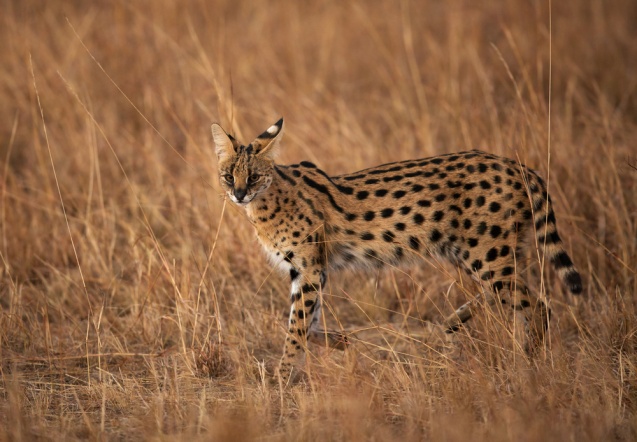 Serval in the bush, South Africa
Serval in the bush, South Africa
With their slender build and golden coat interspersed with black stripes and spots, the serval reminds one of the cheetahs, but smaller and with different markings. They’re known for their long legs in comparison to their body size. They’re the supermodels of the feline world.
Genets (Genetta genetta and Genetta tigrina)
 Large-spotted genet, South Africa
Large-spotted genet, South Africa
The smaller wild cats of Kruger – genets – come in two versions. While the Large-Spotted Genet has black spots with a rusty centre and a black-tipped tail, the Small-Spotted Genet has purely black spots and a white-tipped tail.
When You Meet a Wild Cat in Kruger National Park...
There are often stories in the news of visitors to the park (or to other parks and rehab centres) being injured by animals. This is due to not knowing how to behave when coming across a wild cat.
And that’s exactly what needs to be remembered. While they may look cute and fluffy, these animals are WILD. And you are on their turf.
__medium.jpg) Kruger National Park Safari drive
Kruger National Park Safari drive
Humans are not their prey, but they have an instinct to fight or flee if they feel that they are in any way in danger. Following a few basic rules both your and their safety can be assured while viewing wild cats on a safari drive:
- Quiet! While the animals have become accustomed to the sound of the vehicle, human noise will disturb them, either making them run away, or get angry. If you need to communicate at all, do so in a whisper.
- In most reserves, animals have become habituated to the vehicles used – and their shape. Do not stand up or dangle arms or legs out of the vehicle, as this will frighten the animals and may result in them retreating or attacking.
- Never try to interfere – in any way – with the animals you encounter. This includes trying to change their behaviour or position for a good photo shot and feeding them. The feeding of wild animals is prohibited for both your and the animal’s safety.
These gorgeous African big cats are incredible to see in their natural environment and, as mentioned above, are mainly active at night or late afternoon/early morning. If you have the chance, be sure to go the dawn and/or dusk drives – and night drives in the Greater Kruger National Park – to increase your chance of spotting them! Speak to one of our knowledgeable ABS travel consultants to plan your dream Kruger National Park safari!
If you liked this post, these trips cover similar ground…
- 4 Day Kruger Safari - Walking & Camping Safari
- 6 Day Kruger Park Budget Safari (Backpackers Lodge Tour)
- 7 Day Big Cats, Etosha & Desert Namibia Safari
- 6 Day Kruger Safari & Panorama Route Tour - South Africa


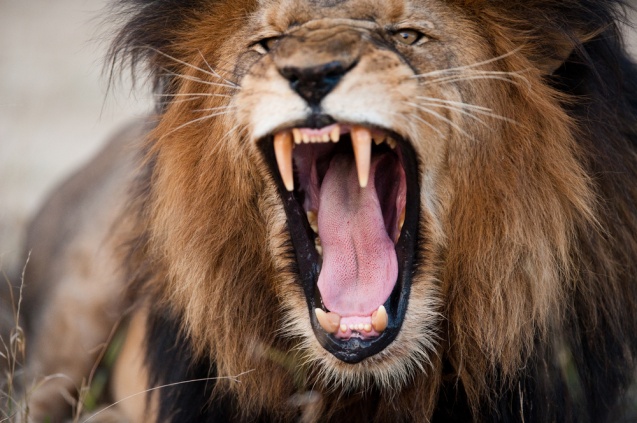
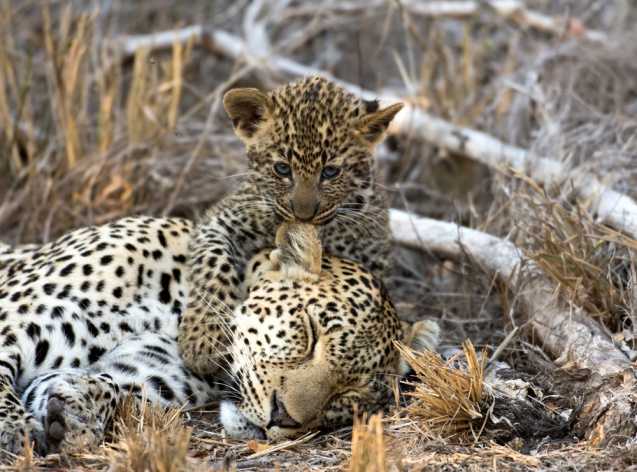
 Briony is a qualified pharmacist, published author and travel blogger living in Cape Town. She writes her own blog about travel, the arts, music and the good things in life, with a focus on accessibility. She likes watching the world go by, and sometimes it makes her nose twitchy, but mostly it provides golden nuggets with which to light up the page.
Briony is a qualified pharmacist, published author and travel blogger living in Cape Town. She writes her own blog about travel, the arts, music and the good things in life, with a focus on accessibility. She likes watching the world go by, and sometimes it makes her nose twitchy, but mostly it provides golden nuggets with which to light up the page.
